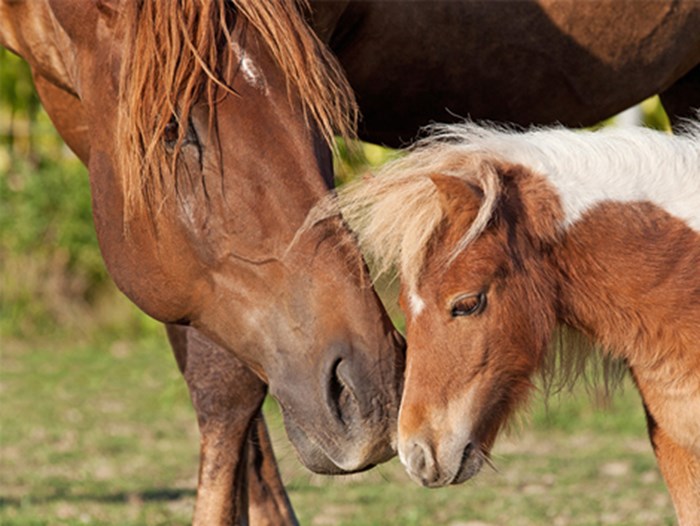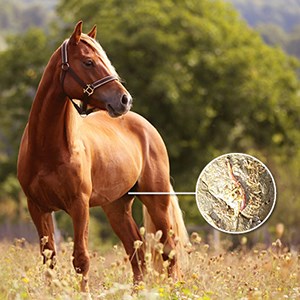Large Strongyle Larval Culturing

The threat of large redworm, Strongylus (spp.) infection is on the rise in UK horses. This parasite's ability to cause sudden, severe, and often fatal colic makes it critical to include specific testing for large strongyles as part of a responsible, targeted worming programme. Westgate Labs now offers a large redworm larval culture testing for all equines, for individual or composite samples (up to four horses), with a turnaround time of two weeks.
Annual screening is especially recommended for:
- Studs and breeding operations with youngstock
- Competition and sales yards with frequent international movement
- Properties with high stocking density or recent horse introductions
- Horses on minimal or selective worming schedules

Large Strongyle larvae culturing in the lab
When to Test for Large Redworm
For routine monitoring, larval culture is a cost-effective and practical option. Research papers show little seasonal variation in large strongyle egg shedding so testing of horses over a year old can be performed at any time of year. For this reason a risk based approach should be applied to testing. (Steuer, Duncan, Ogbourne, et al).
It takes around 6 to 7 months from infection with Strongylus vulgaris before the parasite starts to produce eggs that show up in a faecal sample and can be cultured on for identification.
- For foals:
Test between 7 and 9 months old. Egg shedding from any large redworm infections picked up during summer turnout, is most likely to begin in late autumn. - After potential exposure:
If a horse has travelled or come into contact with others from areas where S. vulgaris may be present, wait at least 7 months before testing, to allow time for the parasites to mature and become detectable.
If you're unsure about timing for your yard or specific horses, we are always happy to offer guidance.
HOW TO TEST
For routine monitoring, larval culturing is a practical and cost-effective method and suitable for regular checks.
Taking the sample is very similar to performing a worm egg count test. An easy-to-use test kit to take the sample, including full instructions and a post-paid return envelope in Westgate Labs’ trademark plastic free packaging, is included in the price, along with follow up help and support from our friendly, qualified team.
The large strongyle larval culture test involves incubating faecal samples under controlled conditions to allow strongyle eggs present to hatch and develop into third-stage larvae. These larvae are then identified under a microscope, enabling accurate differentiation between the large strongyle species, Strongylus vulgaris, Strongylus edentatus, and Strongylus equinus and the more common small redworm species, which are not reported due to their ubiquity. A worm egg count is recommended alongside this test to determine the eggs per gram (EPG) and assess whether treatment for small redworm is necessary. Please allow two weeks from the sample’s arrival at the lab for culture and results.
SENSITIVITY & SPECIFICITY
When well-performed, this technique has a sensitivity and specificity of 73% and 84%, respectively, for detecting S. vulgaris infection (Nielsen et al., 2010).
While the positive predictive value is high (96%), the negative predictive value is substantially lower (37%). In other words, a positive test result is highly likely to be true, whereas a negative result can often be a false-negative. (CANTER Guidelines (First Edition). 2024. https://canterforhorses.org.uk/guidelines/)
BESPOKE VETERINARY SERVICE
-
- Cost-effective compared to molecular testing
- We send out easy to use collection kits for you to distribute to your clients free of charge
- Either you or the client take the sample and submit it to the laboratory in our post-paid, eco friendly packaging.
- The faecal sample(s) are incubated for 10-14 days to allow eggs to hatch into larvae. The larvae are then identified under a microscope based on morphological features.
- We send the results back to you to disseminate to your client
- Services billed monthly in arears.
We have had very positive feedback from the veterinary practices already using this simple system. If you are interested in this service please contact: [email protected] or phone: 01670 791994 to set up your account. Vets already using our service, please contact us to request bespoke paperwork.
More information on Large Redworm
References
Steuer et al. Parasites & Vectors (2022) 15:50. https://doi.org/10.1186/s13071-022-05168-z
James L Duncan. Strongylus Vulgaris Infection in the Horse. PhD. Thesis. University of Glasgow, 1973. https://theses.gla.ac.uk/73217/1/10647724.pdf
Ogbourne. Studies on the Epidemiology of Strongylus Vulgaris Infection Of The Horse. International Journal For Parasitology. 1975. Vol. 5. Pp. 423-426.

LARVAL CULTURING TO DIFFERENTIATE STRONGYLE SPECIES
Test kit includes everything your client needs to take and send a sample for laboratory testing with the results returned to you for dissemination and advice.
- Contact us for details of our competitive pricing structure and suggested selling prices
"Strongylus vulgaris was the archetypal pathogenic gastrointestinal parasite of horses, once considered a major cause of equine colic. Through decades of interval-based anthelmintic administration, the verminous endarteritis and thrombo-embolic colic associated with infection has become clinically insignificant but could re-emerge in the face of more targeted control programmes that reduce anthelmintic administration frequency."
Victoria A Colgate, Emily F Floyd. Common equine parasites: past, present and future. UK Vet Equine.
2025;9(2):66. https://doi.org/10.12968/ukve.2024.0015
“There is significant concern about the re-emergence of large strongyle species, especially Strongylus vulgaris…”
HBLB Code of Practice for the 2025 equine breeding season https://codes.hblb.org.uk/index.php/page/197